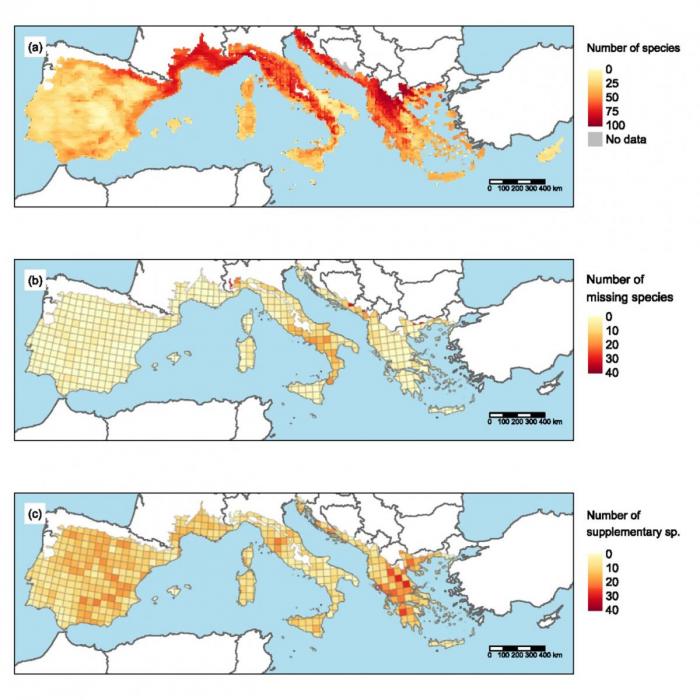Doxa Aggeliki (OT-Med Post-doc)
Anne-Christine Monnet (OT-Med Post-doc)
Kévin Cilleros (OT-Med Engineer)
Agathe Leriche (IMBE)
Numerous international partners
Past conservation strategies have commonly focused on species richness and taxonomic diversity in order to protect threatened, endemic or even common species, but several concerns have already been raised concerning their effectiveness in englobing other biodiversity aspects. More recent approaches stress the importance of maintaining also species functional and evolutionary processes in order to propose effective conservation strategies for ecosystems persistence at different scales. The Mediterranean basin provides a unique diversity of habitats, within which a succession of colonization events has shaped a remarkable diversity of plant species, but it is also among the most threatened biomes worldwide. Trees are keystone species of terrestrial ecosystems in the region and are relevant surrogates of global biodiversity. Future land use pressures may continue to be critical for Mediterranean biodiversity, as one fourth of the remaining refugia areas are actually located in sectors where human density is very high.
This project aims at identifying the complementarity of tree diversity facets, in order to identify actual and future conservation targets. We consider key environmental variables and land-use pressures in the Mediterranean region.
This project collected available data about current distribution of tree taxa, to design and create a long-lasting database of tree occurrences, to gather information on functional traits and phylogeny. The consortium achieved:
- Definition of study area, resolution of the presence grid (10x10km), and targeted tree species (210 species and 245 subspecies), including 44 species of cryptic trees
- Time-calibrated phylogeny of all 64 native tree genera occurring on the European side of the Mediterranean Basin, based on 3 plastid DNA sequences (rbcL, matK, and trnH-psbA), 4 recognized fossil dates and 10 secondary calibrations.
- Development of the WOODIV database (https://www.try-db.org/TryWeb/Home.php), which provides for the Euro-Mediterranean Basin reliable occurrences, four functional traits (plant height, seed mass, wood density, and specific leaf area), sequences from the 3 three DNA-regions (cf above), and modelled occurrences and phylogeny for all 210 Euro-Mediterranean tree species.
- Pilot study of congruence analyses focused on the three facets of tree biodiversity in Mediterranean France: spatial structure varied among diversity facets and spatial autocorrelation patterns were identified for all diversity indices from 30 to 50 km distances. A functional convergence and a phylogenetic divergence were observed ithin tree assemblages comparing to the ones expected given the regional species pool, indicating that even in tree communities with functional similarities, phylogenetic diversity may be high.
- Analyses of spatial patterns of genus-level phylogenetic endemism in the tree flora of Mediterranean Europe, showing that phylogenetic and taxonomic diversity within and among 50x50 km cells are correlated and influenced by soil parameters as well as current, Holocene and Late Glacial Maximum climate. Southern Spain, Cyprus and some Aegean islands contained areas of disproportionately high phylogenetic diversity and a concentration of phylogenetic paleo-endemics, while phylogenetic neo-endemism was high in eastern Sicily. Mixed phylogenetic endemism regions were detected in southern Spain and Portugal, in the Balkans and in Crete. We consider these areas that show a concentration of evolutionary history as targets of high priority for the conservation of the European tree flora.
Geographic scope of the WOODIV database, spatial distribution, and validation of trees occurrences.
a) Number of species within a 10 × 10 km grid cell based on modelled occurrence data for the 171 modelled species, with the addition of the occurrence data of the 21 small-range species; and, within grid cells of AFE (50x50km)
b) Number of species with presences recorded in AFE but not in the WOODIV dataset on the 104 species present both in the AFE and WOODIV data ;
c) Number of species with presences recorded in the WOODIV dataset but not in AFE on the 104 species present both in the AFE and WOODIV data.



